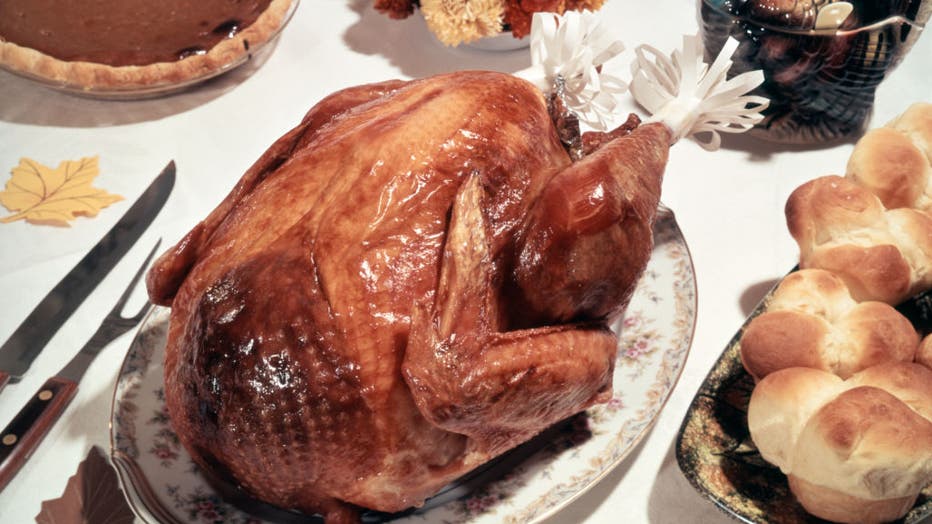Thanksgiving dinner: The origins of our traditional foods
The turkey has become synonymous with the Thanksgiving holiday, as have dishes like stuffing, mashed potatoes, candied yams, cranberry sauce and pumpkin pie.
But historians can’t agree whether turkey was served at the first annual feast between the pilgrims and the Wampanoag tribe. And according to Smithsonian Magazine, the modern Thanksgiving meal shares little resemblance to what was eaten in the autumn of 1621.
The often romanticized feast of 1621 more accurately consisted of ducks or geese, neither of which was the centerpiece of the meal like the modern turkey. Corn was served, but not in the way we consume it today.
Venison was on the menu, as were herbs, onions and oats that were were used to stuff birds or fish.
RELATED: How long do Thanksgiving leftovers last? USDA says 3 to 4 days
The modern Thanksgiving meal took many centuries to develop. And many of the dishes trace their origins to Sarah Josepha Hale, editor of the popular women’s magazine "Godey’s Lady’s Book."
Hale is known for crafting the nursery rhyme "Mary Had a Little Lamb," but she also became a critical figure in the establishment of Thanksgiving and its modern menu.
She petitioned 13 presidents in the 1800s to recognize Thanksgiving as a national holiday. Her efforts included publishing Thanksgiving recipes and menus that featured items like turkey, sage dressing and mashed potatoes, Smithsonian reported.
Abraham Lincoln became the first president to side with her in 1863, recognizing Thanksgiving amid the turning point in the American Civil War.

1960s 1970s THANKSGIVING ROAST TURKEY DINNER (Photo by H. Armstrong Roberts/ClassicStock/Getty Images)
Turkey
Records show turkeys in the Plymouth area at the time of the Pilgrims, but William Bradford — the governor of Plymouth Plantation — sent a group of men fowling. They just as likely could have returned with ducks or geese.
Turkeys trace their origins to central Mexico and the southwestern United States.
RELATED: Don't wash your turkey this Thanksgiving, CDC says
The bird had been twice domesticated in those regions roughly 2,000 years ago. Experts believe Spanish explorers took turkeys from central Mexico back to Europe — then English settlers brought the birds back to their colonies.
The pilgrims used herbs, onions and oats to stuff their fowl or fish, but the modern bread-based stuffing didn’t come along until late in the 18th century.
Potatoes
Historians believe potatoes derived from Peru about 10,000 years ago. The History Channel said the Spaniards probably took the food back to Europe around 1570 and made it a staple crop.
English settlers later brought the crop to the eastern United States. Even so, they had no place at the first thanksgiving. The crop had not become popular enough with the English to have been at the feast.
Pumpkin pie
There was no pumpkin pie at the first Thanksgiving. Historians say the two groups lacked the butter and wheat flour needed to make the pie crust.
And even if they had it, they wouldn’t have crafted an oven needed to bake it.
Even so, the History Channels said English settlers often hollowed out pumpkins, filled the shells with milk, honey and spices to make a custard.
The version we know today, the creamy, cinnamon and nutmeg spiced version, came to be in the 1800s.
Corn
Corn, in many forms, was available in abundance to the pilgrims and natives. It had been domesticated in Mexico more than 8,000 years ago.
According to the History Channel, corn would have been removed from the cob and turned into cornmeal. The natives and pilgrims often boiled and pounded the thick product into a thick corn mush like porridge.
Occasionally, they sweetened it with molasses.
Cranberries
Cranberries are native to North America and quite possibly could have been served at the first Thanksgiving. But it wouldn’t have been in a sauce like the modern condiment.
Neither the natives nor pilgrims would have boiled the berry with sugar with the intent to use it as a sauce for meat, the Smithsonian said.
This story was reported from Atlanta.

